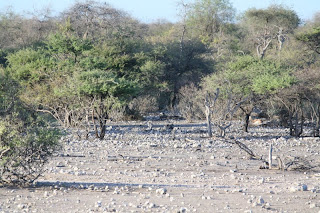







Etosha in the northern part of Namibia means 'place of dry water', and it is centred around a huge, flat calcrete depression (or pan) of about 5,000 square kms. The “pan” tends to take on water only during periods where good rainfall is experienced, but for the rest of the time it provides a great, parched, silver-white backdrop of shimmering mirages to an area of semi-arid savannah grassland and thorn scrub. When the “Pan” does have water present, the growth of blue-green algae is stimulated which in turn attracts Flamingo’s in their thousands
Etosha National Park is one of Africa's major wildlife sanctuaries, being proclaimed a game reserve in 1907 and covering an area of more than 22 750sq kms. The Reserve is managed and controlled by the Namibian Wildlife Department with the facilities in the park being managed by the Namibian Wildlife Resorts group. The Reserve operates under a highly 'managed' environment featuring a cluster of man-made water-points around the central pan and its boundary designated by a patrolled electrified fence.
During the drier months of June to November , where water now becomes a scarce commodity, the man-made water-points attract the big game herds, and forms the centrepiece for visitors looking to see the nearly 150 mammal species to found in the Park, including several rare and endangered species such as the black rhino, black-faced impala, tssesebe and gemsbok.
From a Photographer’s point of view, the landscape can create amazing images. Furthermore the visitor does not have to drive huge distances to find the game. Visit a couple of the waterholes, and let the game come to you !!
Etosha National Park is one of Africa's major wildlife sanctuaries, being proclaimed a game reserve in 1907 and covering an area of more than 22 750sq kms. The Reserve is managed and controlled by the Namibian Wildlife Department with the facilities in the park being managed by the Namibian Wildlife Resorts group. The Reserve operates under a highly 'managed' environment featuring a cluster of man-made water-points around the central pan and its boundary designated by a patrolled electrified fence.
During the drier months of June to November , where water now becomes a scarce commodity, the man-made water-points attract the big game herds, and forms the centrepiece for visitors looking to see the nearly 150 mammal species to found in the Park, including several rare and endangered species such as the black rhino, black-faced impala, tssesebe and gemsbok.
From a Photographer’s point of view, the landscape can create amazing images. Furthermore the visitor does not have to drive huge distances to find the game. Visit a couple of the waterholes, and let the game come to you !!
Having visited most Game Reserves in Southern Africa, I found Etosha to be the best by far. The 3 camps are well managed, with good accommodation and leisure facilities. Game viewing opportunities are excellent,and seeing all of the BIG 5 is not unusual. In recent years Park fees have increased considerably, but it is still worth it. Visit Etosha whilst we can still enjoy wildlife in its natural habitat.
ReplyDeleteUlrich Dannecker